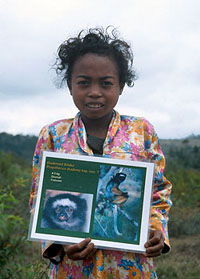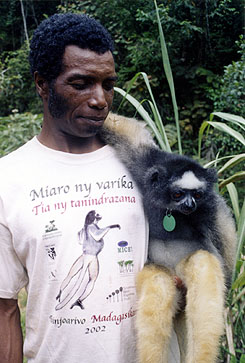Education, Conservation and Local Development
Since beginning research at Tsinjoarivo in 2000, I have increasingly tried to combine research activities with education, conservation and local development. In 2007, Jean-Luc Raharison, Karen Samonds and I formed Sadabe Madagascar, an NGO dedicated to promoting the coexistence of humans and wildlife. With support from Rainforest Trust (USA) and in partnership with Madagasikara Voakajy (Antananarivo), Sadabe is currently leading a 5-year project to expand education, conservation and development activities, as part of the creation of the new Tsinjoarivo-Ambalaomby protected area. Below is a brief summary of our activities to date; please visit Sadabe's website for more information: Sadabe Madagascar |
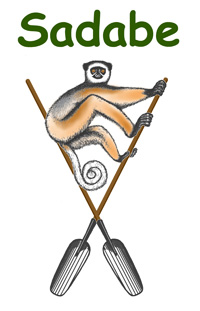 |
Education:
Starting in 2003, our research teams have made periodic visits to local schools (particularly those at Mahatsinjo and Antenina) to hold educational sessions. These included sharing information about the research project, lessons on Madagascar’s biodiversity and language lessons. During these sessions and other visits to village officials, we distributed a conservation pamphlet (“The Lemurs of Tsinjoarivo”), and lemur t-shirts, hats and posters. In 2003 and 2007, we held all-day events for school children during which we brought groups of children into the forest to view the sifaka groups. Despite growing up in the region, many had never seen the animals up close. Finally, in 2004 we designed and constructed informational billboards which were installed at Tsinjoarivo, Mahatsinjo and Vatateza.
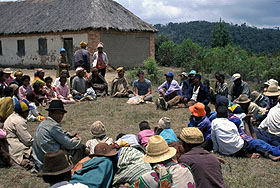 First meeting at Mahatsinjo, 2001 |
|
Because of the underfunded and under-regulated nature of rural schools in Madagascar, the education received in these areas is generally shorter and less helpful than in urban areas. Schools lack supplies and even strong buildings, and teachers are underpaid and under-equipped to teach. In 2004, we collaborated with the Madagascar Ankizy Fund and private donors to build a new public school building in Mahatsinjo, the R.A.H. King school. This building is the only concrete building in the area, and four teachers are working to educate not only the Mahatsinjo children, but many others from neighbouring areas. In 2012, SADABE assumed responsibility for the school, and in 2014 it was officially handed to the local school district. SADABE continues to assist with supplies and programming.
More recently, education efforts have been subsumed within the protected area creation initiative, and include both environmental education, the construction of a secondary school, and training in agriculture and landscape management.
|
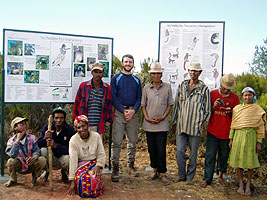 Sadabe billboards installed in 2004 |
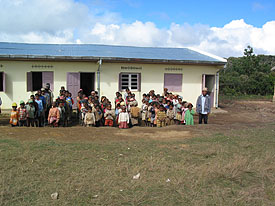 The new school at Mahatsinjo, 2005 |
 Students at Mahatsinjo, 2005 |
Conservation:
In June 2005, Jean-Luc Raharison and I started the Mahatsinjo Co-operative Reforestation Initiative, a project designed to reclaim currently unused fallow land and grow corridors between isolated forest fragments. This project is moving ahead as a collaboration between our research project (TFFP), the local people of Mahatsinjo, the Mayor of Tsinjoarivo Commune, and the Water and Forest Service office at Ambatolampy. The initiative was launched at a meeting attended by all parties during which 12 corridor areas were decided upon by consensus for the first round of corridor building.
 Tree nursery constructed in 2005 |
The first phase (2005-2006) involved marking corridor areas and experimental plantings of various pioneer trees that grow well in full sunlight - including Seva (Solanum mauritianum) and Voarafy (Maesa lanceolata), two common species at Tsinjoarivo. We also built a tree nursery and started to produce seedlings (a mix of nursery-grown and transplanted seedlings was used to maximize production). |
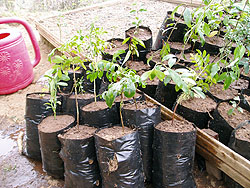 Seedlings growing at tree nursery |
During the second phase (2006-2007) we employed dozens of local villagers to install signs and plant the corridors - in all more than 55,000 trees were planted. We plan to continue monitoring and protecting the existing corridors, while potentially expanding the project to neighbouring regions. An assessment of corridor areas in August 2008 indicated a high survival rate and no encroachment by villagers. We will continue to engage local people as nursery staff, seed collectors, and corridor guardians, and plan to integrate future planting with projects for school children. Reforestation is now an ongoing part of the protected area creation initiative, along with plantations of economically valuable non-native timber species in non-forest areas. |
Development:
Medical and dental care is extremely limited at Tsinjoarivo, and many people do not receive basic care because of the cost and the long distance they must travel to reach doctors (15 km) and dentists (75 km). During July 2007, we hosted a Madagascar Ankizy Fund dental mission (“Fitsaboana Nify”) at Mahatsinjo, including one dentist and professor from Stony Brook University and five dental students. During 8 days, the team treated more than 200 patients from Mahatsinjo and surrounding regions, including many with badly infected teeth and gums. The team provided extractions of teeth that were badly decayed, restorations for teeth with minor decay, endodontic reconstructions (root canals), and instruction in oral health. They also collected data on dental health, to be used in planning future missions.
The first dental mission indicated such a pressing need for dental care that the Madagascar Ankizy Fund sent a second dental team in July 2008, which included even more personnel (2 dentists, 4 dental students, 2 dental assistant, and one full-time educator) and once again treated more than 200 patients.
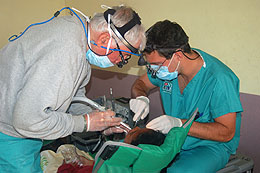 Dr. Larry Wynn and dental student Matt Battiste working on a patient at Mahatsinjo |
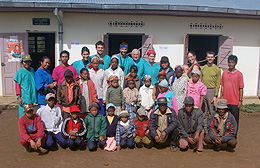 The Madagascar Ankizy Fund dental team with local patients |
| Finally, since 2009 Sadabe has been initiating a wide number of development initiatives in the Tsinjoarivo region, starting in the village of Mahatsinjo. These initiatives include: building and stocking fishponds, including local breeding of fingerlings, beekeping, and rabbit breeding. Sadabe enters into contracts with individual villages, providing training and materials for economic development in villages that agree to protect local biodiversity. More recently, extensive socioeconomic development work is being carried out as part of the protected area creation, most notably including agricultural training initiatives and a health clinic run by SADABE at the Mahatsinjo research station. | |
Bernardo and Rene, who train local people at Mahatsinjo, showing the carp species selected for breeding
|
Mats created to provide carp with breeding sites in local ponds |

